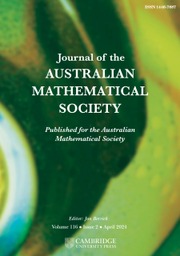No CrossRef data available.
Article contents
THE SPECTRAL EIGENVALUES OF A CLASS OF PRODUCT-FORM SELF-SIMILAR SPECTRAL MEASURE
Published online by Cambridge University Press: 21 July 2025
Abstract
Let  $\mu _{M,D}$ be the self-similar measure generated by
$\mu _{M,D}$ be the self-similar measure generated by  $M=RN^q$ and the product-form digit set
$M=RN^q$ and the product-form digit set  $D=\{0,1,\ldots ,N-1\}\oplus N^{p_1}\{0,1,\ldots ,N-1\}\oplus \cdots \oplus N^{p_s}\{0,1,\ldots ,N-1\}$, where
$D=\{0,1,\ldots ,N-1\}\oplus N^{p_1}\{0,1,\ldots ,N-1\}\oplus \cdots \oplus N^{p_s}\{0,1,\ldots ,N-1\}$, where  $R\geq 2$,
$R\geq 2$,  $N\geq 2$, q,
$N\geq 2$, q,  $p_i(1\leq i\leq s)$ are integers with
$p_i(1\leq i\leq s)$ are integers with  $\gcd (R,N)=1$ and
$\gcd (R,N)=1$ and  $1\leq p_1<p_2<\cdots <p_s<q$. In this paper, we first show that
$1\leq p_1<p_2<\cdots <p_s<q$. In this paper, we first show that  $\mu _{M,D}$ is a spectral measure with a model spectrum
$\mu _{M,D}$ is a spectral measure with a model spectrum  $\Lambda $. Then, we completely settle two types of spectral eigenvalue problems for
$\Lambda $. Then, we completely settle two types of spectral eigenvalue problems for  $\mu _{M,D}$. In the first case, for a real t, we give a necessary and sufficient condition under which
$\mu _{M,D}$. In the first case, for a real t, we give a necessary and sufficient condition under which  $t\Lambda $ is also a spectrum of
$t\Lambda $ is also a spectrum of  $\mu _{M,D}$. In the second case, we characterize all possible real numbers t such that
$\mu _{M,D}$. In the second case, we characterize all possible real numbers t such that  $\Lambda '\subset \mathbb {R}$ and
$\Lambda '\subset \mathbb {R}$ and  $t\Lambda '$ are both spectra of
$t\Lambda '$ are both spectra of  $\mu _{M,D}$.
$\mu _{M,D}$.
MSC classification
Information
- Type
- Research Article
- Information
- Journal of the Australian Mathematical Society , Volume 119 , Issue 2 , October 2025 , pp. 246 - 263
- Copyright
- © The Author(s), 2025. Published by Cambridge University Press on behalf of Australian Mathematical Publishing Association Inc.
Footnotes
Communicated by Ji Li
The research is supported in part by the NNSF of China (Nos. 12201206 and 12371072) and the Hunan Provincial NSF (No. 2024JJ6301).


